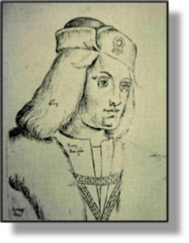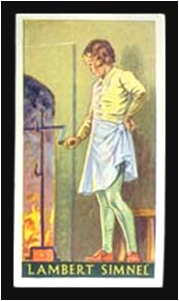


PERKIN WARBECK c1474 -
 xxxxxThe son of a local Flemish official, Perkin Warbeck had various jobs before ending up at Cork in southern Ireland in 1491. A vain and easily-
xxxxxThe son of a local Flemish official, Perkin Warbeck had various jobs before ending up at Cork in southern Ireland in 1491. A vain and easily-
xxxxxHe journeyed to the continent where he was coached in his new and unexpected role by Margaret, Duchess of Burgundy (Edward IV's sister). He was then received at the French court as the rightful claimant to the English throne, and also gained the support of Maximilian I of Austria. Indeed, so concerned was Henry at this turn of events that he invaded France in 1492 and, by the Peace of Étaples, forced Charles VIII of France to expel Warbeck and pay a large indemnity into the bargain. But this did not put paid to the threat. Now assured that King James IV of Scotland, plus a large slice of the English nobility would rally to his cause, Warbeck -
xxxxxTwo attempts, both made in 1495, were far too feeble and ended in failure, but in 1496 James of Scotland invaded Northumberland in support of Warbeck's cause, and in the following year, 1497, the pretender landed in Cornwall and mustered a force of some 3,000 men. The rebel army attempted to take Exeter, but was met by royalist troops and quickly put to flight. Warbeck made his escape, but was captured at Beaulieu in Hampshire and taken to London. In 1498 he publicly confessed to his treason and was imprisoned in the Tower of London. There he might well have stayed had he not attempted to escape the following year. Seen as a potential danger to the crown, he was then convicted of treason and hanged.
xxxxxIncidentally, the English playwright John Ford (1586-
xxxxxIt was in 1491, while in Ireland, that the young Perkin Warbeck was persuaded by Irish dissidents to lay claim to the English throne as the Duke of York (presumably murdered in the Tower in 1483). He then travelled to the continent where he received the support of France and Austria. So concerned was Henry VII that he invaded France in 1492 and forced the French to expel Warbeck. In 1497, following a Scottish invasion, Warbeck landed in Cornwall and mustered some 3,000 men. But they failed to take Exeter, and Warbeck was eventually captured. He was imprisoned in the Tower of London and, after attempting to escape, was convicted of treason and hanged in 1499.
Including:
Lambert Simnel

xxxxxAn earlier attempt to dethrone the Tudors was made in 1487 by a young man called Lambert Simnel (c1475-
xxxxxIn fact, the  revolt centred around Warbeck was not the only Yorkist uprising faced by Henry in the opening years of his reign. An earlier but less dangerous attempt to overthrow the first Tudor monarch had been based around a young man called Lambert Simnel (c1475-
revolt centred around Warbeck was not the only Yorkist uprising faced by Henry in the opening years of his reign. An earlier but less dangerous attempt to overthrow the first Tudor monarch had been based around a young man called Lambert Simnel (c1475-
xxxxxIn 1487, having travelled to Ireland (where sympathy for the Yorkist cause was considerable), Simnel was crowned at Dublin as Edward VI. He then landed in Lancashire with a sizeable force -
xxxxxThe Battle of Stoke Field is considered by some historians as the last conflict of the Wars of the Roses, based on the fact that John de la Pole, the Earl of Lincoln -



Acknowledgements
Warbeck: 16th century drawing, French school, artist unknown – Municipal Library, Arras, France. Simnel: from cigarette card depicting famous minors – George Arents Collection, Public Library, New York.
H7-